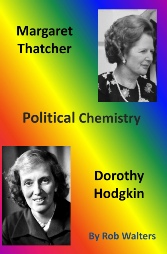
If you like it, please share it

Who, What and When
This little book contains fictional conversations between two famous women: Margaret
Thatcher and Dorothy Hodgkin. There is an important link between them -
Margaret Thatcher requires no introduction. She was a staunch Conservative and the
first woman Prime Minister of the UK. In her own lifetime she became famous throughout
the world. Dorothy Hodgkin is less well known, though in the world of biochemistry
she is very famous indeed. Using X-
Margaret was the daughter of a grocer from Grantham, a small market town in Lincolnshire. Dorothy was the daughter of a colonial civil servant. Their upbringing was very different, their attitudes to life, morality, religion, marriage, in fact almost everything, poles apart.
Both women were highly intelligent. However, whereas Margaret was a thrusting, confident, abrasive woman with little tolerance for those she thought of as fools; Dorothy was a shy, unobtrusive, friendly woman with no taste for the labyrinthine committee politics of academic Oxford.
The inspiration for this book came from my day job as an Oxford city guide. Whilst
designing a new walking tour based on North Oxford I thought how refreshing it was
to talk about famous women for a change rather than exclusively men. Most tours focus
on the older colleges, all of which were for men only until the 1970s, whereas North
Oxford is the home of the early women's colleges. Prime amongst these famous women
are Dorothy and Margaret of Somerville College. I began to wonder, given their strong
links at Oxford and extremely different characters and opinions, what those intimate
moments at the end of a one-
On the lighter side, what right have I to imagine the conversations which might have
taken place between these two interesting women? Well, my first name is Robert and
Margaret's surname at the relevant time was Roberts. My wife's name is Margaret.
We called our first goat Dorothy. I have had my photograph taken with Margaret Thatcher
(and quite a few other people) at a conference in Salt Lake City. I live almost equidistant
between the college of both women, Somerville, and Dorothy's main Oxford residence
in the Woodstock Road. Margaret Thatcher privatised me back in 1984 (along with about
a quarter of a million others in British Telecom). As mentioned, I am nowadays a
city guide in Oxford and regularly talk to my groups about the two famous ladies.
I have, during my life, traversed a well-
When I created these conversations fifty years had passed since Dorothy received the Nobel Prize and just under a year since Margaret died. It therefore seemed timely to write this little work of historical fiction, if that is what this is. The Historical Novel Society decrees that a historical novel "must have been written at least fifty years after the events described, or have been written by someone who was not alive at the time of those events". Well, I just fail on the latter, but forgive me since I was alive, but not sentient, at the time.
The meetings between the two women are assumed to have taken place in the 1946/7
academic year. So, travelling back to that time, Dorothy and Margaret are thirty-
Most of the facts used during the conversations are true, but, once again, the conversations are fictional, though they do at times utilise utterances based loosely on the two women's own words.
Margaret Thatcher once asserted that she and Dorothy did not discuss politics -
SAMPLE
Margaret Thatcher and Dorothy Hodgkin
Political Chemistry
25,000 words
Click below for price and delivery

Paper Book
Kindle eBook


